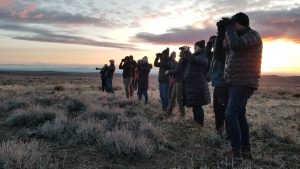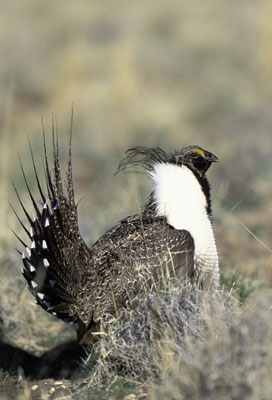In a Life Raft on the Sagebrush Sea: Part I
The Suburban bounced around in the predawn darkness on a double-wide dirt road, casting gravel off both shoulders. It was still well before 5 AM. We had left Boise almost an hour earlier, in a caravan with two other vehicles, carrying environmental journalists from every corner of the country. ICL and Idaho Department of Fish and Game had been tasked with taking about 20 well-seasoned journalism professionals – in town for the annual Society for Environmental Journalists Conference – into a vast sagebrush sea to witness an elusive natural event that most had only read about.Since leaving the downtown hotel garage, our capable pilot, ICL Public Lands Director John Robison, had been spinning tales of the local ecology and past conservation efforts almost without pause. As we crested a rise and he slowed our rig in response to the glowing red tail lights ahead, the suspense and excitement that had been building over the last two hours reached a palpable crescendo. Truck doors opened – and remained that way. An obvious hush (coached in advance by our other trip leaders, Michelle Kemner from IDFG and BSU professor, Jen Forbey), washed over the group as we donned down jackets, wool hats, and binocular harnesses. One by one, we crossed under strands in the barbed wire fence, like a string of pronghorn apprehensively moving toward wintering grounds.  After walking 200 yards or so, Michelle’s gaze focused directly across a shallow swale in front of us. The dawn light was barely filtering through a sparsely-clouded eastern horizon line. Rose and purple hues mixed with sage-green clumps as far as the eye could see – as if constructing the foreground of a three-dimensional watercolor painting. To the west, distant cliffs of weathered rhyolite enjoyed the first pure rays of amber sunshine.Michelle raised her binos, and the group followed suit, instinctually knowing that they just found what they had all come to witness. Something moved. Then something else moved. Low, between the sage shrubs – even the naked eye could discern activity. Dark, football-shaped objects scooted amongst the sage sea in some sort of divinely choreographed drama. Many would alternately slow, then strike a swollen pose, displaying an impossible fan of spiked feathers and a prominent chest ruff that resembled two ostrich-sized eggs, sunny-side up.
After walking 200 yards or so, Michelle’s gaze focused directly across a shallow swale in front of us. The dawn light was barely filtering through a sparsely-clouded eastern horizon line. Rose and purple hues mixed with sage-green clumps as far as the eye could see – as if constructing the foreground of a three-dimensional watercolor painting. To the west, distant cliffs of weathered rhyolite enjoyed the first pure rays of amber sunshine.Michelle raised her binos, and the group followed suit, instinctually knowing that they just found what they had all come to witness. Something moved. Then something else moved. Low, between the sage shrubs – even the naked eye could discern activity. Dark, football-shaped objects scooted amongst the sage sea in some sort of divinely choreographed drama. Many would alternately slow, then strike a swollen pose, displaying an impossible fan of spiked feathers and a prominent chest ruff that resembled two ostrich-sized eggs, sunny-side up.  A greater sage-grouse lek is the desert environment’s corollary to spawning grounds for salmon. This very particular geographic feature has been selected by a migratory creature for satisfying highly specific requirements for annual breeding rituals and proximity to prime nesting habitat. While the birds may not return to the same exact lek each year (depending on a variety of sometimes little-understood factors), they do key in on vast swaths of undisturbed habitat that allow linkage to wet meadows for summer rearing of juveniles – sometimes up to 100 miles away.As the spectacle of the annual courtship and mating sequence of the sage-grouse unfolded before us, it elicited wonder and respect. It also gave rise to lots of questions from the journalists. Michelle and Jen are Idaho’s foremost experts currently working on sage-grouse. Over the next couple of hours, they educated the group of journalists on basic life-history characteristics of the birds, their iconic presence on the western sagebrush-steppe landscape, and the extremely fragile status of their declining populations. Jen explained how the birds have such a honed nutritional palate, that adults will often focus on not just a particular subspecies of sagebrush, but on a particular side of an individual sagebrush plant or even a specific branch. Michelle spoke about the dual threats of large-scale fire and proliferation of invasive annual grasses within prime sage-grouse habitat, like cheatgrass.For decades, biologists have tracked precipitous declines in sage-grouse populations and lek counts across 11 western states and 2 Canadian provinces. The scientific literature documents a range-wide loss of over 80% of the sage-grouse population in the last 50 years. The threats don’t stop at fire and invasive plants. Transportation infrastructure, energy development, agriculture conversion, mining, improper grazing practices, and drought also present significant concerns for sage-grouse habitat. Each of these impacts to the birds are, of course, exacerbated by the effects of climate change and have led to the acknowledgement that the sagebrush-steppe ecosystem is among the most imperiled in North America. Of a historic range of almost 300 million acres, less than 10% are still classified as high-quality sage-grouse habitat. And even that small chunk continues to lose over 1 million acres annually. More than 350 species of conservation concern use this highly-threatened landscape.
A greater sage-grouse lek is the desert environment’s corollary to spawning grounds for salmon. This very particular geographic feature has been selected by a migratory creature for satisfying highly specific requirements for annual breeding rituals and proximity to prime nesting habitat. While the birds may not return to the same exact lek each year (depending on a variety of sometimes little-understood factors), they do key in on vast swaths of undisturbed habitat that allow linkage to wet meadows for summer rearing of juveniles – sometimes up to 100 miles away.As the spectacle of the annual courtship and mating sequence of the sage-grouse unfolded before us, it elicited wonder and respect. It also gave rise to lots of questions from the journalists. Michelle and Jen are Idaho’s foremost experts currently working on sage-grouse. Over the next couple of hours, they educated the group of journalists on basic life-history characteristics of the birds, their iconic presence on the western sagebrush-steppe landscape, and the extremely fragile status of their declining populations. Jen explained how the birds have such a honed nutritional palate, that adults will often focus on not just a particular subspecies of sagebrush, but on a particular side of an individual sagebrush plant or even a specific branch. Michelle spoke about the dual threats of large-scale fire and proliferation of invasive annual grasses within prime sage-grouse habitat, like cheatgrass.For decades, biologists have tracked precipitous declines in sage-grouse populations and lek counts across 11 western states and 2 Canadian provinces. The scientific literature documents a range-wide loss of over 80% of the sage-grouse population in the last 50 years. The threats don’t stop at fire and invasive plants. Transportation infrastructure, energy development, agriculture conversion, mining, improper grazing practices, and drought also present significant concerns for sage-grouse habitat. Each of these impacts to the birds are, of course, exacerbated by the effects of climate change and have led to the acknowledgement that the sagebrush-steppe ecosystem is among the most imperiled in North America. Of a historic range of almost 300 million acres, less than 10% are still classified as high-quality sage-grouse habitat. And even that small chunk continues to lose over 1 million acres annually. More than 350 species of conservation concern use this highly-threatened landscape.  As an “obligate” species living exclusively in sagebrush country, sage-grouse populations are extremely vulnerable to declining conditions of their essential habitat. The birds have completely disappeared from Nebraska and Kansas, as well as across the entire Canadian province of British Columbia. An estimated 16 million birds gathered around lekking areas and riparian corridors 100 springs ago. Now, there may be as few as 200,000 that continue to fulfill this annual cycle. They sit, precariously, in a life raft on the stormy sagebrush sea.The sun was now directly overhead and the grouse had flown off over the ridge or disappeared into the scenery. Given the troubled status of sage-grouse and the curious nature of journalists, the subject of the Endangered Species Act surfaced on the trip back to town. Many were surprised by what they heard…Stay tuned for Part II of “In a Life Raft on the Sagebrush Sea” in our next Wildlife Program blog post, and sign up for Wildlife Program email updates to ensure it hits your mailbox.
As an “obligate” species living exclusively in sagebrush country, sage-grouse populations are extremely vulnerable to declining conditions of their essential habitat. The birds have completely disappeared from Nebraska and Kansas, as well as across the entire Canadian province of British Columbia. An estimated 16 million birds gathered around lekking areas and riparian corridors 100 springs ago. Now, there may be as few as 200,000 that continue to fulfill this annual cycle. They sit, precariously, in a life raft on the stormy sagebrush sea.The sun was now directly overhead and the grouse had flown off over the ridge or disappeared into the scenery. Given the troubled status of sage-grouse and the curious nature of journalists, the subject of the Endangered Species Act surfaced on the trip back to town. Many were surprised by what they heard…Stay tuned for Part II of “In a Life Raft on the Sagebrush Sea” in our next Wildlife Program blog post, and sign up for Wildlife Program email updates to ensure it hits your mailbox.

